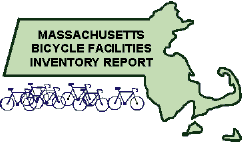
Next: Description by Region
| Top: MassPaths Home Page |
| Up: Table of Contents | |
| Previous: Executive Summary | |
Next: Description by Region |
IntroductionThe bicycle facilities inventory project of which this is the final report was conceived in 1994 by the Bureau of Transportation Planning and Development (BTP&D) of the Massachusetts Executive Office of Transportation and Construction (EOTC). The Massachusetts Highway Department (MHD) entered into a contract with the Bicycle Coalition of Massachusetts (BCOM) to carry out the project. The goal of the project was to provide a region-wide and statewide overview of existing and proposed bicycle facilities. This included the preparation of a report as well as an inventory of facilities stored in a computer database and on maps. The project describes existing and potential bicycle facilities in several categories defined by the project’s scope of work:
In describing special facilities for bicycle travel, the report is quite comprehensive. Some existing and proposed facilities may not have come to the attention of project staff, but most did, thanks to a statewide series of well-publicized public meetings. The inventory of roadway facilities, however, can not be comprehensive. All public ways in Massachusetts are open for bicycling except for posted limited-access and express state highways. Only a small fraction of these were brought to the attention of project staff. Most were described either as especially attractive bicycle routes or as facilities in need of improvement to meet an existing demand. Due to the local and dispersed nature of parking accommodations, many of them also escaped the inventory. Most parking facilities described to the inventory are recent or proposed installations by municipalities, public agencies and authorities. In addition to preparing the inventory, BCOM was given the task of suggesting cross-state routes, two from east to west and three from north to south. Rationale for the bicycle facilities inventoryThe major impetus for this project was a need felt by the BTP&D for a comprehensive list of bicycle facilities, both existing and proposed. Without such a list, determining the context of individual proposals that came to the attention of the BTP&D was difficult. In particular, it was often difficult to determine the relationship of one proposed facility and/or existing facility to other proposed and existing facilities. A further goal of the project was to prioritize the inventoried projects. Prioritization was to be based, to the degree possible, on objective, transportation-based measures, with input from citizens, BCOM, regional planning agencies (RPAs) and the BTP&D. Data collection and review processData collection and review were a complicated process that represented the bulk of the work on the project. This process comprised several phases, described below. Initial meetings and preparation for the public input processTo discuss the project and prepare for the public input process, project staff held initial meetings with representatives of all of the 13 RPAs in December 1994 and January, 1995. Most RPAs submitted information on bicycle facilities, ranging from comprehensive bicycle transportation plans to scattered projects. The BTP&D provided maps for scratchpad use at public meetings. Project staff generated a database structure, using a Pentium PC-compatible computer and Microsoft Access database software. Most of the RPAs provided mailing lists of citizens and of city and town officials interested in transportation projects. Meeting announcements were sent to the names on these mailing lists, as well as the following lists:
First round of public meetingsIn February and March of 1995, a first round of public meetings was held in each of the 13 RPAs. The purpose of these meetings was to collect suggestions for bicycle facilities, and to answer questions. BCOM developed forms to provide uniform collection of data and provided these forms at the public meetings. Attendees could use data forms to describe suggestions for facilities. Many attendees supplied maps or additional descriptions. BCOM also provided maps on which attendees could draw the location of proposals or existing facilities. For some larger projects, the forms were no more than a cover sheet for submissions. Reviewing data and setting draft prioritiesFollowing the first round of public meetings, suggestions were reviewed, entered into the computer database and sketched on maps. In addition, preliminary prioritization was conducted by BCOM and reviewed by the RPAs. This prioritization incorporated transportation-based measures, and was assessed using a numerical matrix. Prioritization is based on numerical criteria established by the BTP&D, incorporates initial suggestions by project staff, and reflects input at public meetings. Second round of public meetingsA second round of public meetings was held in April and early May of 1995 to allow public review of the input data. These meetings led to corrections to the data which had already been assembled, as well as a number of additional suggestions. The meetings also served as a public forum for comment on the draft priorities. With a few exceptions, which will be noted in the sections on the individual RPAs, attendees were substantially in agreement with the priorities which had been established by the RPAs and BCOM. Review of data from second meetings and finalization of prioritiesFollowing the second set of meetings, additional collected data was entered into the computer database. BCOM staff discussed any possible changes in prioritization with the RPAs, and in some cases, priorities were revised. This report was written, and reviewed by BTP&D staff. The section for each RPA was then reviewed by that RPA’s staff. The RPA’s choices governed when there were substantial differences of opinion about priorities. These priorities should be understood as only for the purpose of this project. Several of the RPAs are preparing planning documents which may reach different conclusions or set priorities based on different criteria. |